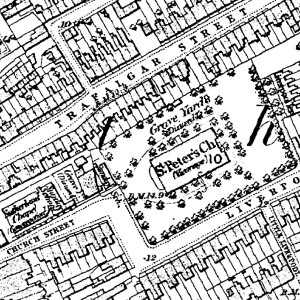1:2,500 County Series
The first maps at 1:2,500 (roughly 25 inches to the mile, or roughly one
square inch to one acre) were Published in 1855 with coverage of the
cultivated parts of Great Britain being completed in 1896. By then, a Almost every man-made feature of any significance is displayed on these maps
which thus form a definitive record of the changing landscape of Britain
since the middle of the 19th century. They are of considerable importance to
historians (although this would have been inconceivable to their creators).
The detail zooms in to house-level and offers a wealth of additional
information concerning land usage, communications and boundaries. For
genealogists they are of particular use and interest. Not only do they offer
countless research clues which no other source can match but they also
reveal every nuance of the landscape inhabited by past generations, so
helping to explain many of the preoccupations and limitations that ruled
|
 Ordnance Survey's first maps, produced in response to the fear of Napoleonic
invasion, were published in 1805 at a scale of one inch to the mile. As the
century progressed, however, it became clear that more detailed maps were
needed for purposes such as land registration, public sanitation, railway
construction, civil defence and the administration of the Tithe and
Enclosure Acts. The experiment of the Irish mapping produced at 1:10,560 in
the 1820s proved successful and – after prolonged debate about the scale,
format and (inevitably) the cost of the new surveys – it was eventually
agreed that the whole country would be surveyed at 1:2,500 except for areas
of moorland and mountain where 1:10,560 was deemed sufficient. The small
army of surveyors was once more despatched across Britain while teams of
engravers and printers in Southampton eagerly awaited the material this
operation would so painstakingly collect.
Ordnance Survey's first maps, produced in response to the fear of Napoleonic
invasion, were published in 1805 at a scale of one inch to the mile. As the
century progressed, however, it became clear that more detailed maps were
needed for purposes such as land registration, public sanitation, railway
construction, civil defence and the administration of the Tithe and
Enclosure Acts. The experiment of the Irish mapping produced at 1:10,560 in
the 1820s proved successful and – after prolonged debate about the scale,
format and (inevitably) the cost of the new surveys – it was eventually
agreed that the whole country would be surveyed at 1:2,500 except for areas
of moorland and mountain where 1:10,560 was deemed sufficient. The small
army of surveyors was once more despatched across Britain while teams of
engravers and printers in Southampton eagerly awaited the material this
operation would so painstakingly collect.